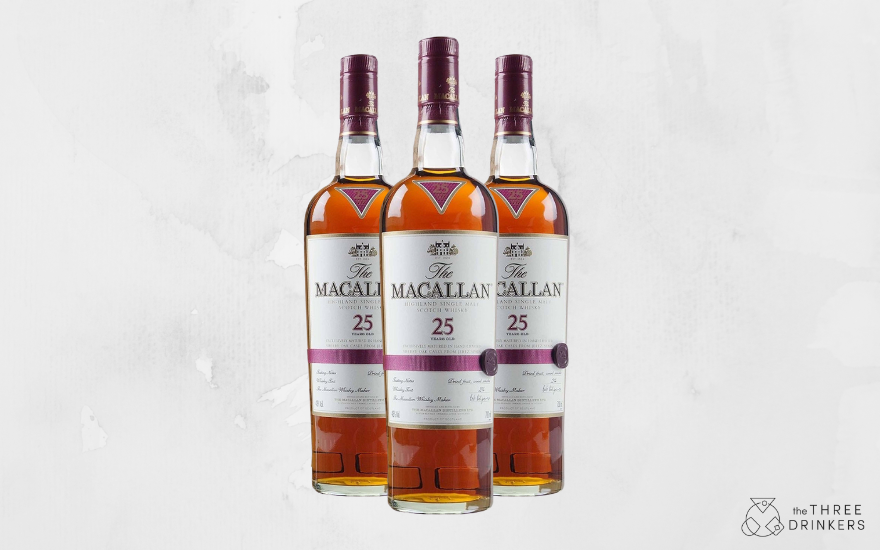Like Marmite, sherry matured whiskies split whisky drinkers. However, those who like them are some of the most ardent fans in the world, being hugely loyal to their favourite brands. There are the superstars of the sherry whisky world like Macallan and Glenfarclas, but then there are other distilleries producing incredible drams. Their fans will probably not be too pleased I’m putting this list together as some of the whiskies are not made in huge numbers and the more popular, they become, the harder it will be to find them. But for those die-hard fans, they will always find a way.
Macallan
Lets start with the king. Macallan is the undisputed king of sherry matured whiskies. It is the most expensive and the best known brand of sherry whiskies in the world. But this doesn’t mean to say it is the best. There will be many who argue it is, but the rest of this list will show you something to compare it with. But for now, let’s start with a classic.
ABV: 43%
Size: 700ml
Find here: UK £1499.95 // US $2499.99
Glendronach
The contender. This whisky is becoming better known. The distillery has a cracking 18 year old which is a big and powerful sherry bomb, fulfilling the most ardent of sherry bomb lover’s desires. Each year the distillery also releases some special single cask expressions. These are less expensive than Macallan and rarer, and some would say even more delicious. They are hard to come by, but the 18 is a great place to start.
ABV: 46%
Size: 700ml
Find here: UK £97.94 // US $179.99
Tamdhu
The sleeper. This distillery came under new ownership in the not too distant past, and they pledged to cask all the liquid that will find its way into a Tamdhu bottle will be matured in a sherry cask. They have a batch released cask strength bottle which is epic, and their regular expressions are exceptional with the oldest at the moment being a 15 year old. An 18 year old is on the way we’re told. I can’t wait.
ABV: 46%
Size: 700ml
Find here: 18 year old UK £78.95 // 15 year old US $72.99
Glenfarclas
Always good value. Glenfarclas has been under the same family ownership for its entire existence. This means the stock they hold has never been re-valued and sold in a distillery sale. This means that they can sell the whisky at a very reasonable price. Although prices have been creeping up over the years to keep roughly in line with other brands, they have a 15 year old which is fabulous, and the best place to start trying sherry style whiskies if you haven’t already.
ABV: 46%
Size: 700ml
Find here: UK £48.95
Kavalan
Kavalan is in Taiwan and has been making excellent whisky since only 2005. Since then they have become a cult name in whisky and even won the best single malt whisky in the world in 2015. I know how good it was, I was one of the judges. They now produce a series called the solist, of which some are sherry matured whiskies and there is certainly the same DNA in these whiskies as the world-beating dram in 2015.
ABV: 56.3%
Size: 700ml
Find here: UK £340
Glenmorangie
The hybrid. This whisky isn’t purely matured in sherry, is has spent the first ten years of its life in a bourbon barrel and then a further two in a sherry cask. I would say this is another great place to have a go at a sherry style whisky. With soft spices it gives an introduction to the genre without scaring the horses. For those who like bourbon matured whisky, this will still please, but for those about to start their sherry adventure, it will give you a taste of what might come in the future.
ABV: 43%
Size: 700ml
Find here: UK £41.75 // US $44.99
The Glenrothes
The little brother. The Glenrothes distillery is owned by the same company as Macallan. For many years another company owned the brand, and they were an old school company called Berry Bros & Rudd founded in 1598. This old school thinking used old school technics and they worked. They used a lot of sherry in their maturation and were not nearly as expensive as Macallan. The Edrington Group, owners of Macallan have now taken the brand back from Berry Brothers & Rudd and are keeping the emphasis on sherry. Still much cheaper than Macallan, but for how long is anyone’s guess. Classic whisky, and deservedly on this list.
ABV: 43%
Size: 700ml
Find here: UK £99.79 // US $159.99
The Dalmore
The old timer. The Dalmore has been known for their sherry style whiskies for many years. But they have kept innovation going. Rather than maturing in a single style of sherry cask, like an oloroso cask for example, they mature their whisky in multiple styles of sherry casks. For example with their King Alexander III expression, they mature the whisky in no less than six styles of sherry cask. Including Oloroso, but also Matheusala and Apostoles. The results are divine and although one might pay a premium for premium whisky, it is well worth digging deeper into your wallet for this one.
ABV: 40%
Size: 700ml
Find here: UK £159.80 // US $279.99
There really is a sherry whisky for everyone, at every level of sherry from bomb to balanced and at every price point too. If you haven’t tried a sherried style of whisky before, give it a go. What’s the worst that can happen? You find out you don’t like it and can drink the other 90% of whiskies produced. But if you do, you will open up a whole new drinking experience.
I think that the next big thing in sherry whiskies is going to be Tamdhu, and if you’d like to learn a little more about this Macallan beater, read on with a Tamdhu attitude.










